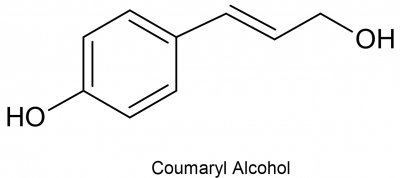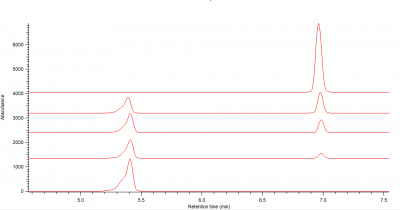Preparation of coumaryl alcohol
Joseph Sampson, 10/12/21
This is a continuation of a project started in 2018 by A. Tibbs.
Coumaryl alcohol is a monomer of lignin. It has a molar mass of 150.1745 g/mol.
Coumaryl alcohol will be synthesized from coumaric acid through two separate reactions:
- First, coumaric acid will be converted into ethyl coumarate through esterification. This will involve converting the carboxylic acid group into an ethyl ester group.
- Finally, ethyl coumarate will be converted into coumaryl alcohol through a reduction reaction.
The experiment performed is based off of Quideau and other and Schafer et. al in which the authors previously synthesized coumaryl alcohol. The Synthesis of p-Coumaryl Alcohol subheading is what's important.
- Initial procedure for the Synthesis of Coumaryl Alcohol (simplified):
- Add 1g (0.0061 moles) of p-Coumaric acid and 5mL (0.07 moles) acetyl chloride into a round bottom flask containing 50mL of dry ethanol. The total concentrations of coumaric acid and acetyl chloride in solution should be 0.111M and 1.27M each.
- Stir at room temperature for 17 hours.
- After 17 hours, evaporate the solvent.
- Repeat steps 1-3 again.
- Recrystallize the product from ethyl acetate (product should be ethyl p-coumarate).
- Add 640mg of ethyl coumarate to 30mL of toluene and place this solution on ice and under nitrogen.
- To the mixture on ice and under nitrogen, SLOWLY add 12mL of DIBAL-H.
- Stir for 1hr while still ice-cooling and under nitrogen.
- Add 5mL ethanol to quench the reaction and then mix some more.
- Partially remove the solvent under reduced pressure (???)
- Add 50mL water and mix.
- Transfer mixture to separatory funnel and add ethyl acetate, shake it up, and then extract the aqueous layer. The organic layer contains coumaryl alcohol [don’t lose any of it!!].
- Repeat step 12 three more times (4 extractions total).
- Recrystallize the organic layer (coumaryl alcohol) from dichloromethane. The product should look like pale yellow crystals.
10/13/21
The article's authors noted that they let the coumaric acid (CA) + acetyl chloride (AC) reaction sit for 17 hours before evaporating the solvent and repeating the same procedure again. However, it's not known whether two sets of 17 reaction hours each is necessary to produce ethyl coumarate in sufficient yield. To figure out how much time it takes to fully react CA, a kinetics experiment was performed. 1.0062g of CA was solubilized in 50mL of dry ethanol, yielding a 122.67mM solution. From there, 10uL of the CA solution was diluted 100-fold in dry ethanol to bring the final concentration to 1.2267mM in 1mL total volume. After that, 5mL of AC was added to the 122.67mM CA solution to start the reaction (final concentrations of CA and AC were 111.5mM and 1.270M each). The reaction was immediately timed and just like before, 10uL samples of the mixture were diluted 100-fold in dry ethanol at different time intervals (5 minutes, 1 hour, 3 hours, 5 days). Each of the five diluted samples were analyzed using Reversed-Phase High Performance Liquid Chromatography (RP-HPLC) instrumentation to monitor the amount of product formed.
Results
HPLC data recorded after the five day-long kinetics experiment from 10/7/21 to 10/12/21.
Order of graphs (bottom to top): Initial CA mixture, CA + AC mixture after 5 minutes, CA + AC mixture after 1 hour, CA + AC mixture after 3 hours, CA + AC mixture after 5 days. Each tall peak displayed represents a given molecule and the time it took for it to separate from the mixture and elute out of the column. The left peak is the CA starting material while the right peak is the product formed. As the reaction time increases, the height of CA's peak decreases while the product's height increases. This shows that the reaction is occurring as expected. From the CA peak of the initial graph (y=1327.6) to CA's peak after three hours (y=648.43), half of the starting material is remaining. It can be concluded that by reacting 111.5mM with 1.270M AC for three hours, half of the CA will convert to product. Additionally, after five days of the reaction, all of CA reacted to form product.
11/21/21
- The ethanol solvent was pulled out of solution using a rotary evaporator, leaving acetyl chloride and ethyl coumarate in the round bottom flask.
- The temperature of the water bath and condenser were each at 35oC and 4.6oC.

